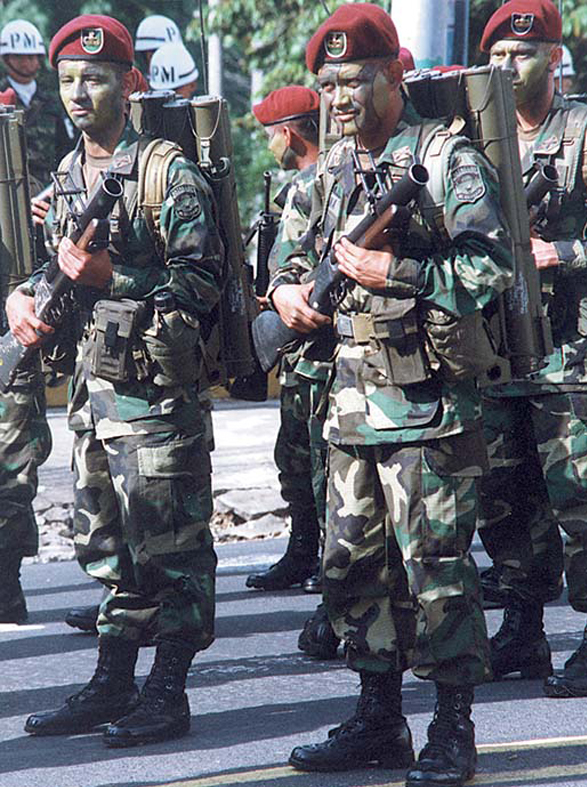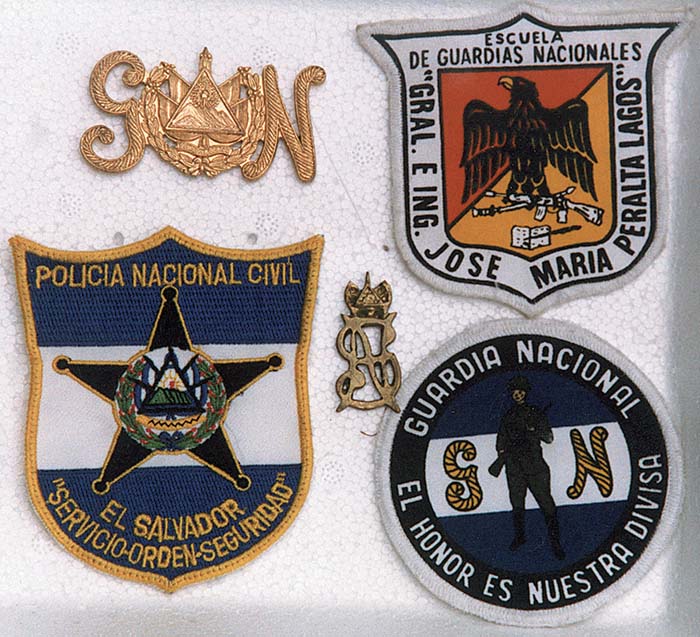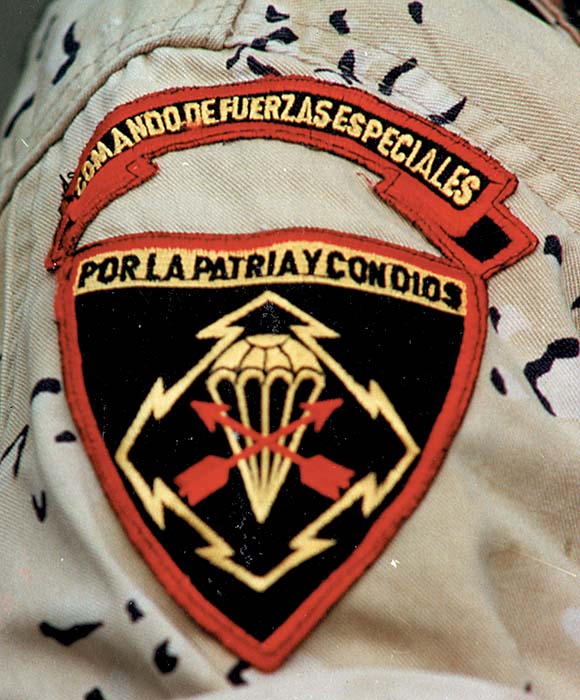Members of the elite Salvadoran Parachute Battalian equipped with M79 grenade launchers and M72 LAWs. Photo by Julio Montes
By Julio A. Montes
For most of last decade, Communist guerrillas of the FMLN (Farabundo Marti National Liberation Front) fought the Armed Forces to a standstill in El Salvador. The FMLN fielded some 10,000 fighters assisted by Cuba and the Nicaraguan Sandinistas. The Army deployed almost 60,000 soldiers and militarized police. It depended on one Special Forces Group, five large rapid infantry reaction battalions, one parachute battalion, and one light armored cavalry regiment to spearhead its attack. The rest of the Army was distributed in 6 Infantry Brigades, 1 Artillery Brigade, 7 Military Detachments, and 1 Engineer Detachment.
Between 1945 and 1962, the Army was organized in 6 Infantry brigades, one Artillery Regiment and one Cavalry Regiment. The 1st Infantry Brigade consisted of the 1st, 2nd and 3rd Infantry Regiments (San Carlos Barracks, San Salvador), the Artillery Regiment (El Zapote Barracks, San Salvador) and the Cavalry Regiment (Casa Mata Barracks, San Salvador). The 4th Infantry Regiment (Sonsonate), and the 5th and 6th Infantry Regiments (Santa Ana) formed the 2nd Infantry Brigade. The 7th and 8th Infantry Regiments of Chalatenango formed the 4th Infantry Brigade, with the 9th (Cuscatlan), and 10th (San Vicente) Infantry Regiments formed the 5th Infantry Brigade. The 6th Infantry Brigade comprised the 11th (La Paz) and the 12th (Usulutan) Infantry Regiments. The 3rd Infantry Brigade deployed the 13th (San Miguel), 14th (La Union), and 15th (Morazan) Infantry Regiments. This organization would change considerably before the civil war.
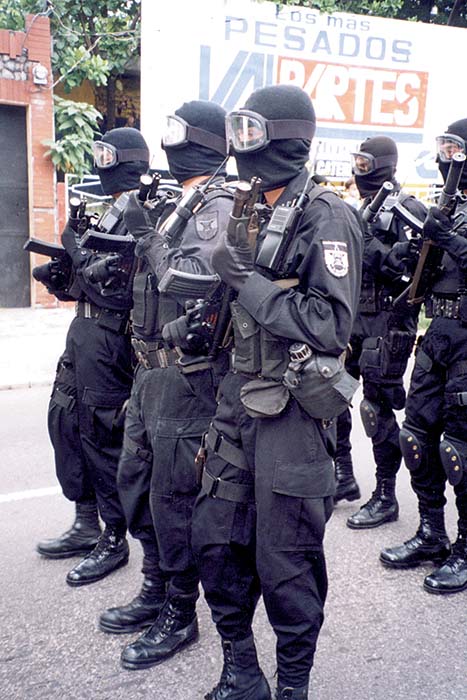
The 1918 Organic Law of the National Guard ordered the formation of 14 Guard Companies with a Cavalry Section attached to each unit. The basic patrol element was the pair, with several pairs housed at a Guard Post (Puesto); several Post formed a Line (Linea), and in turn several Lines formed a Command (Comandancias of 1st or 2nd Classes). Several Commands formed a Tercio (equivalent to a Regiment). The National Guard was incorporated as an elite specialized outfit within the Army.
This unusual position was demonstrated in war. During the 1969-war with Honduras, the National Guard formed the so-called Expeditionary Force “TACO,” with the 1st, 2nd and 3rd National Guard Companies as forward units. The 4th, 5th, 6th, 7th, 8th and 9th National Guard Companies and the Mortar Company (81mm types) were deployed as the main elements of TACO force. The Logistical Operational Base, at Aguacatan, operated with the 10th Guard Company (Logistics), the Transport, and the Signal Groups. In addition, the Destacamento Montes (under CPT Aristides Napoleon Montes), comprising the reinforced 11th Guard Company, was established to assists the Army at the Northern Operational Theater. While the Destacamento Monterrosa (under CPT Domingo Monterrosa) organized with the 12th, 13rd, and 14th Guard Companies to assists the Eastern Operational Theater. The war lasted 4 days, but demonstrated the capabilities of the National Guard as an infantry element of the Army.
In fact, by the time of the civil war, the Salvadoran Law Enforcement agencies were under military command, and comprised three Public Security Corpses. These consisted of the the Guardia Nacional Corps (National Guard), in charge of rural police functions; there was a Policia de Hacienda Corps (Treasury Police), in charge of the national revenue service. Urban law enforcement fell under the responsibility of the Policia Nacional Corps (National Police). The smaller Policia de Aduanas (Custom Police) was incorporated into the Treasury Police during the conflict. In the interim post-war period, the customs duties went to the National Police. The Peace Treaty ordered all these units disbanded, and the establishment of a new internal security entity, under the command and control of civilian authority.
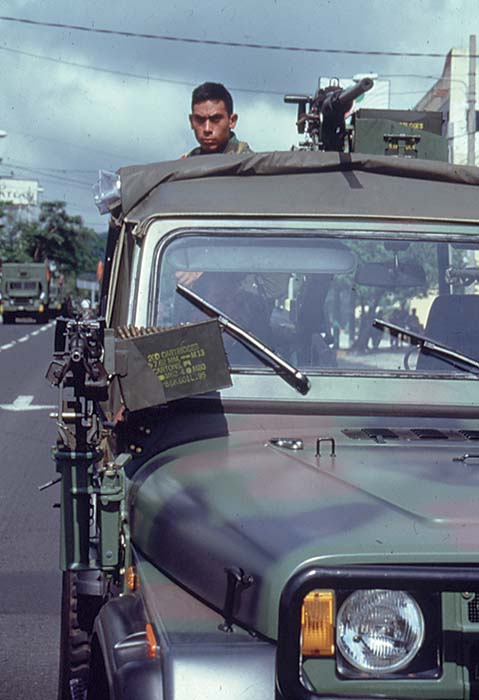
SMALL ARMS
The Salvadoran Army received 7mm Remington rifles in the early 1900s, but by 1920 the Chilean-made Mausers in 7mm and French Hotchkiss Model 1914 machine guns were standard issue. Up to 1931, the Cavalry and Artillery regiments were still equipped with the elderly and heavy Gatling machine guns. The Army was eventually modernized with the acquisition of quantities of 9mm Steyr Solothurn SMGs, and Madsen M1934 and Solothurn MG-30 machine guns.
Soon after WWII, the Army received quantities of 7.92mm VZ24 Mausers and 9mm M46/M53 Madsens from European sources. The 0.30” Madsen Saetter machine gun was also acquired for support and as replacement of the Hotchkiss M1914 and Colt PTFA machine guns. The 57mm Madsen Platoon Mortar came along from Dansk Industri Syndikat, Denmark. By 1961 the entire National Guard was equipped with the M1 Carbine and the Madsen M1934 and Saetter machine guns. The standard side arm was the FN Mle.35 GP High Power, but the 0.45” M1911A1 was encountered as a highly prized badge. The regular Army was re-equipped with the semi-automatic Garand. The US had delivered more than 1365 0.30” M1 Garands between the end of WWII and 1965 together with more than 100 0.30” M1919A6 delivered by 1977.
General Jose Alberto Medrano was commander of the 1st Infantry Brigade prior of taking command of the National Guard. As such, he yielded considerable power in the military regimen of the time. By 1968, Medrano had re-equipped the entire National Guard with modern 7.62mm G3 rifles. The Army followed, and by the time El Salvador went to war with Honduras in 1969, the regular Army had been equipped with HK G3 rifles and 7.62mm HK-21 light machine guns.
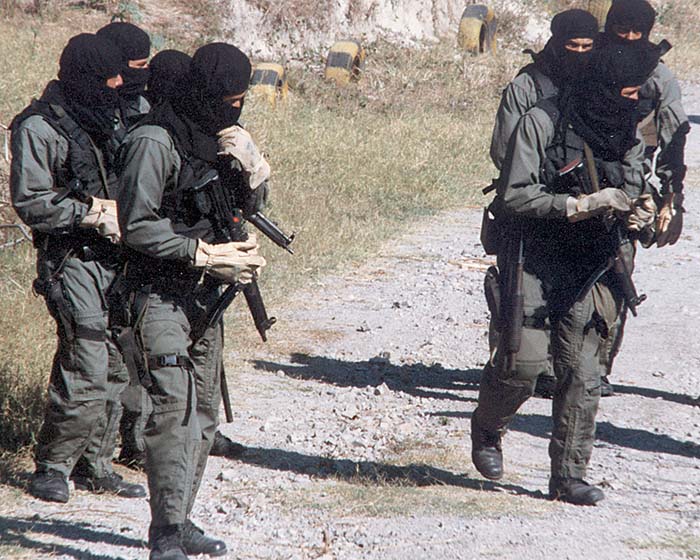
The National Guard again played a crucial role in the re-equipment of the Army when it adopted the MP5 as the standard submachine. General Ramon Alfredo Alvarenga contracted for the first of 8000 MP5s purchased by El Salvador in the late 1970s. In fact, the Salvadorans were one of the first customers of this superb weapon. There was also an introduction of some 2000 5.56mm HK-33s. Those observed in the hands of officers were equipped with 40 round magazines, and telescoping stocks. However, the HK-33 was soon discarded and replaced with the 5.56mm M4.
Without a doubt, the Guard’s police methods were rudimentary and obsolete. The Guard was known for its violent acts, but not so much for corruption. Nevertheless, the guerrilla commanders demanded the National Guard disbanded as a concession from the government to reach a peace agreement. The guerrillas also demanded the rapid reaction battalions (Atlacatl, Atonal, Arce, Belloso, and Bracamonte Bns.), the Directorate of National Intelligence, and the two other Security Corps be disbanded as well.
The former installations and some of the former guardsmen were incorporated into the newly established Army Special Brigade of Military Security (Brigada Especial de Seguridad Militar – BESM). This unit deploys the 503rd and the 504th Military Police Battalions, and the 501st and 502nd Border Guard Battalions; there are a Support Battalion, a Security Company, and an Instruction Company. The MP battalions are equipped exclusively with refurbished MP5s.
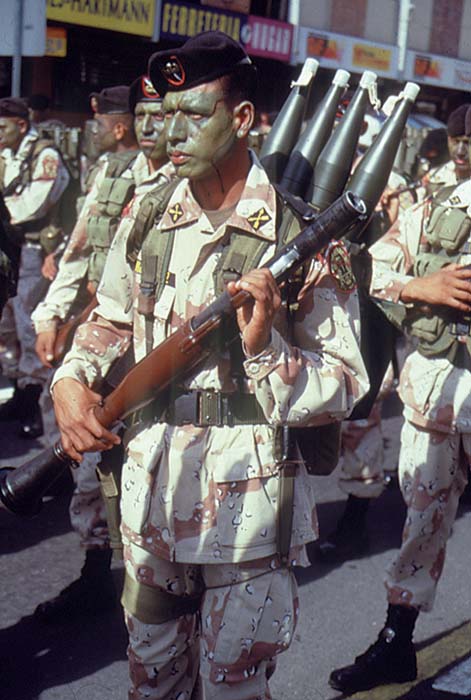
FROM HK TO COLT
By the mid-1970s the Salvadoran Armed Forces had been completely equipped with Heckler & Koch products coming from both Germany and France. Material included G3 rifles in all variants and HK-21 LMGs. This simplified training and knowledge of Infantry weapons and logistics.
The Israeli 9mm UZI replaced the Madsen SMG in 1975, but due to unclear reasons, the UZI had been replaced with the MP5 by 1979. The UZI and Madsen were relegated to second-line units. The FN Mle.35 GP continued as the preferred side arm.
By the early 1980s, Argentina entered the picture, delivering US$17 millions in military aid. The material delivered included 9mm FMK M35 High Powers and 9mm FMK-PA-3 SMGs manufactured at the Domingo Matheu factory at Rosario. Taiwan followed with the delivery of hundreds of 5.56mm T-65 rifles.
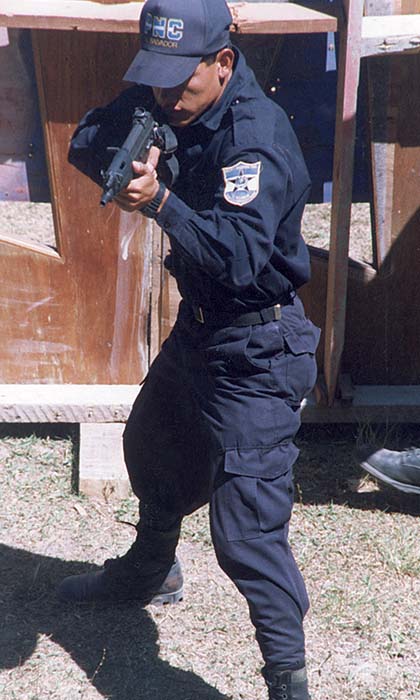
American aid poured into El Salvador after 1981. The US delivered 32,629 M16A1s between 1981-84. The US supplied 1640 40mm M79 and 224 M203 grenade launchers during the same period. Nevertheless, the Security Corps and many other Army units refused to exchange their G3s for the M16. Therefore, the US supplied hundreds of semiautomatic G3 rifles, including numbers of G3A4 types with telescoping stocks for the Parachute Battalion, and quantities of 7.62mm M14 rifles.
The complete infantry was eventually re-equipped with the Colt M16A1 rifles. Thousands of additional surplus M16A1s, and M203s were delivered between 1985 and 1991. The G3 was retained solely by the National Guard and the Treasury Police. Some Civil Defense units also received surplus G3s and M14s. The Armed Forces Workshop refurbished all the HK G3s, HK-21s and MP5s in the late 1980s & early 1990s.
In 1985, the Cavalry Regiment received the first 500 Colt M16A2 rifles. These were in reality the 14” short barrel 5.56mm submachine gun variant with telescoping stock. It was denominated M16A2 because it had not been typified by the US Army yet. The Salvadorans were the first customers of this “new” weapon. Many of us simply referred to it as the CAR-15 for its roots to the Vietnam-era model. The weapon was eventually adopted by the US Army as the M4 submachine gun and the 16” barrel variant as the M4 Carbine. The 5.56mm M4 SMGs and Carbines replaced the 9mm MP5s and 5.56mm HK-33s in the hands of the officers and mechanized infantry.
For high precision duties, the Army had adopted the Austrian Steyr SSG69. However, with the expansion of the Army, more high precision weapons were needed. Surprisingly, the US delivered 211 Sniper M1D Garands. During this time, Soldier of Fortune magazine personnel assisted in modifying some G3s as closely as possible to G3SG/1 standards. Fortunately, the M1Ds were soon followed with more modern M21 and M24 types.
Until then, the Army had done well using the HK-21 for platoon level support and the heavier Saetter, M1919A4 and M1919A6 machine guns were kept as vehicle mounted weapons. However, the US delivered 598 M60 and M60Ds between 1981 and 1983. Hundreds more followed. The Armed Forces Workshop (Maestranza) modified many 0.30” Madsen Saetter to 7.62 x 51mm NATO standards to augment the arsenal, an effort that could had been better spent on the M1919 types.
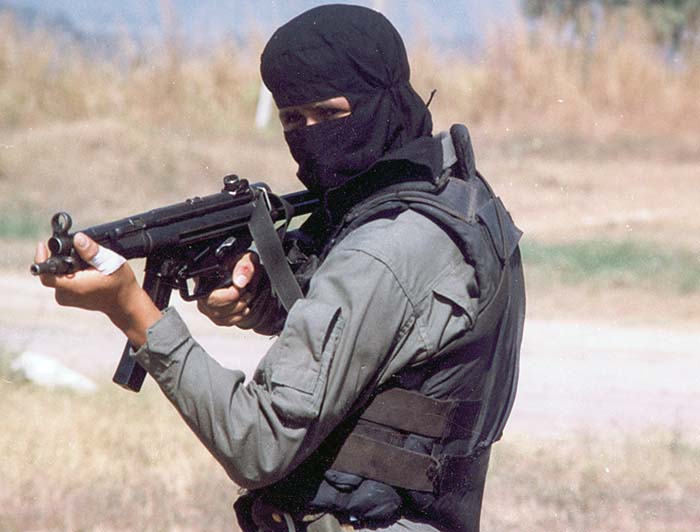
THE NEW POLICE
Today, all law enforcement activities are in the hands of the National Civilian Police (Policia Nacional Civil – PNC). This law enforcement agency has received considerable international assistance. It is now rated as the best and most modern police force in Central America.
The police were first equipped with surplus equipment from the Army and former National Police. Army officers turned over their M9 Berettas and High Power Brownings and these were supplied to the police along with new .357 Magnums. However, the pistols were insufficient to fight criminals in El Salvador.
The war had left huge quantities of weapons in the hands of criminals. As an initial measure, the PNC incorporated hundreds of new 7.62mm AKM and older 5.56mm M16s rifles found in huge former guerrilla warehouses. The government added numbers of surplus 5.56mm T-65, stock 5.56mm Mini-14/20GB and Ruger AC-556, some G-3 rifles, and new Mossberg and Remington shotguns. With the arrival of Chilean assistance, the police acquired the 9mm SAF submachine gun.
The SAF is basically a SIG551 scaled-down to a 9mm caliber. The SAF was acquired in several variants: fixed stock, folding stock, short machine pistol, and silenced model. In 1995, the PNC decided to transfer all automatic rifles back to the Army. The PNC retained the pistols, SAF submachine guns, and shotguns. The government also looked for a new standard police issue rifle. The favorites were the semiautomatic version of the 5.56mm SIG551 for compatibility with the SAF, and the 5.56mm HK G-41 for compatibility with the MP5. The advantage of the G-41 was that it accommodates the 20 and 30 round M-16 type magazines.
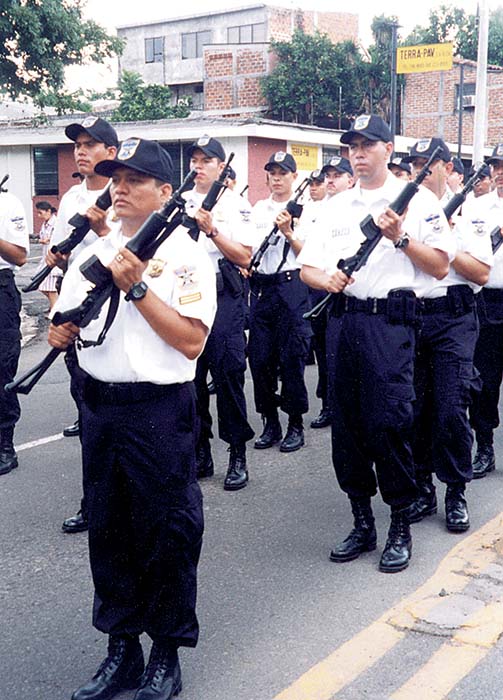
In 1998, the PNC contracted for 1500 semiautomatic 5.56mm Galil rifles, which beat the others due to price. The Galil is a great rifle, but-as with the lonely SAF in service—it does complicate logistics in this poor country. Prior to this, the few 5.56mm Galils found in El Salvador had been either captured from the guerrillas or abandoned by the Nicaraguan National Guard in 1979. A better choice for the police would have been the newly developed IMI MAGAL rifle in 0.30” caliber, capable of taking the M1 Carbine magazine. In fact, the Army now is trying to dispose of thousands of M1/M2s, and magazines are readily available. Under the Military Assistance Program and direct sales, the Salvadorans had acquired some 5000 M1s and about 156 M2s by 1964. More Carbines arrived during the 1960s and 1970s. The 7.62 x 33mm rounds (0.30”) fired by the M1/M2s are still adequate for most police tasks. The Police could have taken over the Army surplus M1 & M2. Furthermore, the PNC would have been able to refurbish them and upgraded with stocks made of Zytel. The M1/M2 could had been issued to foot patrols while the more compact and modern MAGAL would had gone to the motorized units. Ammunition could have been standardized in 9mm for pistols and SMGs and 7.62 x 33mm for the MAGAL & M1/M2.
The acquisition of the Galils was followed by the adoption of the 9mm CZ-75 as the standard police sidearm. This is a superb pistol at a reasonable price. The CZ-75 is recoil-operated, using the Browning dropping barrel system. I have one of these pistols in my collection and can say that it is a pleasure to shoot. It is likely that the PNC will acquire the CZ-75 Compact pistol to complement the full-size model. The Compact model accepts 10 and 13 round magazines, and it would be ideal for off duty and undercover duties. Ironically, the Army Officer Corp exchanged the M9 and Mle.35 High Power for the 9mm Jericho (Baby Eagle), which is in essence a copy of the Tanfoglio (Italy) built CZ75
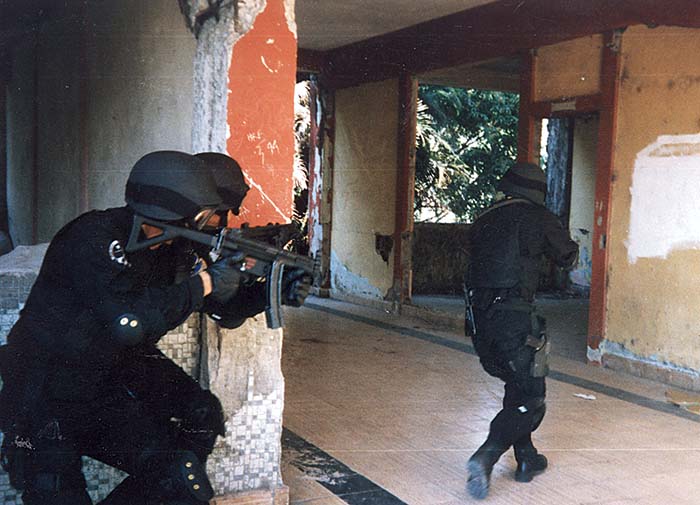
The elite Police Reaction Group is equipped with better equipment than the Army. This includes new and highly priced 9mm SIG P-228 pistols, 9mm MP5 submachine guns, and 7.62mm SIG-3000 precision rifles. The Group leadership acquired seventy 5.56mm HK-53 short barreled rifles. The unit also requested-and acquired—four more SIG-Sauer 3000 precision rifles together with 10 sniper gear sets, 3 electric generators, 8 scuba gear sets, and two Zodiac boats.
AFTERMATH
It is noticeable that gun laws have been “liberalized” in El Salvador, and weapons can be purchased legally in the country. During the war, any one without connections to the government caught by government forces with a 9mm pistol or a 22 rifle could have been considered a rebel. On the other hand, if the rebels caught any one with a gun, they consider him an informant. The other option was to be considered a potential fighter by either side and recruited on the spot. Gun control was never effective, and only left the guns in the hands of the warring factions.
Large corporations can afford private security. According to data supplied by Arturo Villeda and Gustavo Gomez, from the PNC Public Relations Section, there are 62 Private security agencies accounting for 5936 security guards, 2926 of them armed. However, the typical citizen depends on the police for security. Due to the lack of sufficient manpower, several operations are taking place with the assistance of the Army. There are as many as 5,000 soldiers involved in rural police activities.
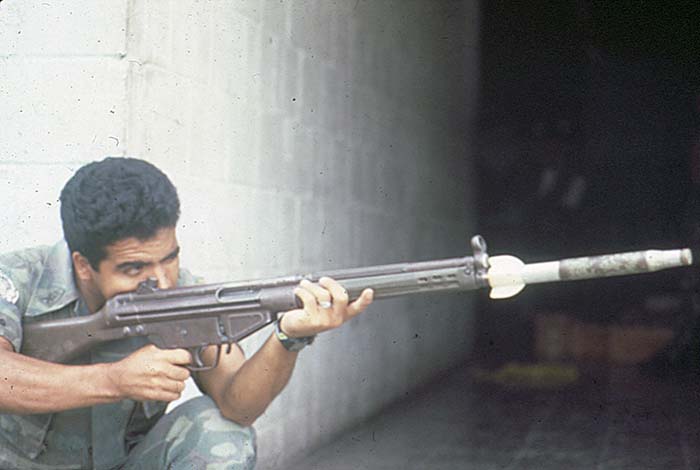
Crime has become the most important issue for the Salvadorans. In particular the drug traffic and money laundering have severely damaged the local economy. Drugs are now a big post-war problem. The police confiscated about 5 tons of cocaine recently at San Jorge, busting 7 former-national policemen and a Mexican member of ONUSAL (UN Mission in El Salvador)1.
The corruption that was rampant during the war at all levels became more apparent after the war. Even high level politicians and aristocrats have become suspects of drug trafficking and other illicit activities. War heroes are exposed as common criminals, and former combatants fight each other to settle old scores.
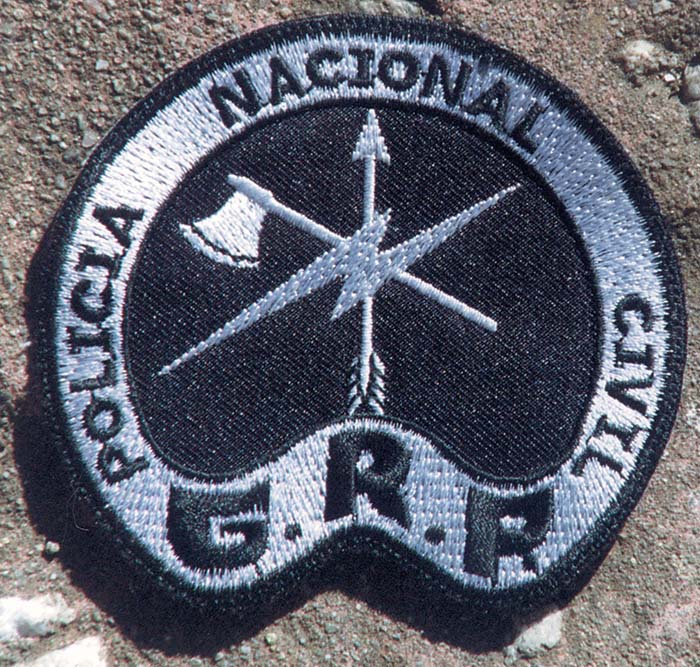
Numbers of deportees have joined gangs such as “Mara Salvatrucha” and “Mara de la 18,” both with links to the Crips and the Bloods gangs in the US. The gangs have formed an unexpected subculture of the Salvadoran society. Unfamiliar to these new threats, popular sectors are now asking the Army to go back to the streets to clean them out.
The Army is equipped with 9mm Jericho pistols, 5.56mm M4 SMGs and Carbines, and M16A1 rifles, 7.62mm M14 rifles (for special units only), M79 and M203 grenade launchers, M60 and M2HB machine guns. It would be a good investment to acquire kits to convert the hefty 25 lb M60s to lighter M60E3 and E4 models. The Military Police and Special Forces continue to use refurbished 9mm MP5s. Troops would had preferred the 9mm GLOCK or SIG models to the Jericho, and the Colt 9mm SMG should be acquired in place of the MP5s for compatibility with the M16.

For those interested, the Salvadoran Army is trying to dispose of the large excess small arms arsenal. There are relics in new conditions: new M1/M2 Carbines, M1D Garands, Mausers, MG-30 ect. There are also refurbished G3s, Madsens, UZI SMGs and many others. The money acquired from the sale of excess equipment will be used to improve the remaining arsenal with kits, and new parts.
| This article first appeared in Small Arms Review V3N8 (May 2000) |



